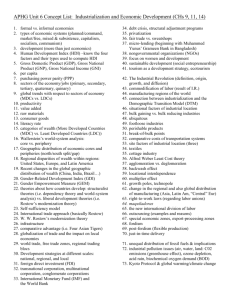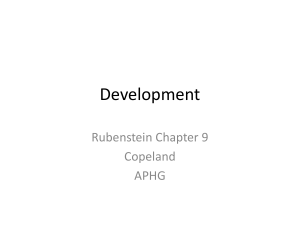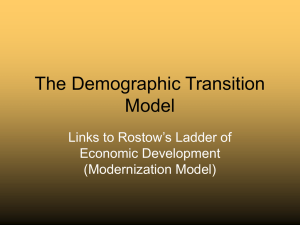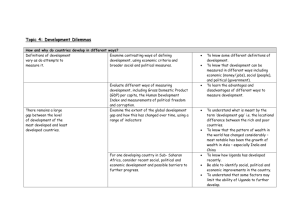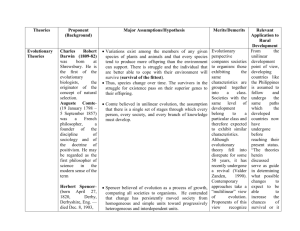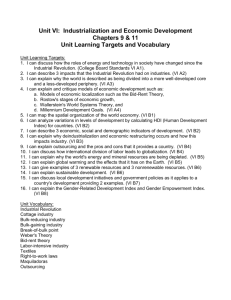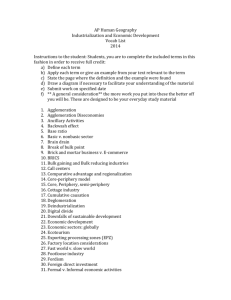Modernization Theories - Personal Home Pages (at UEL)
advertisement
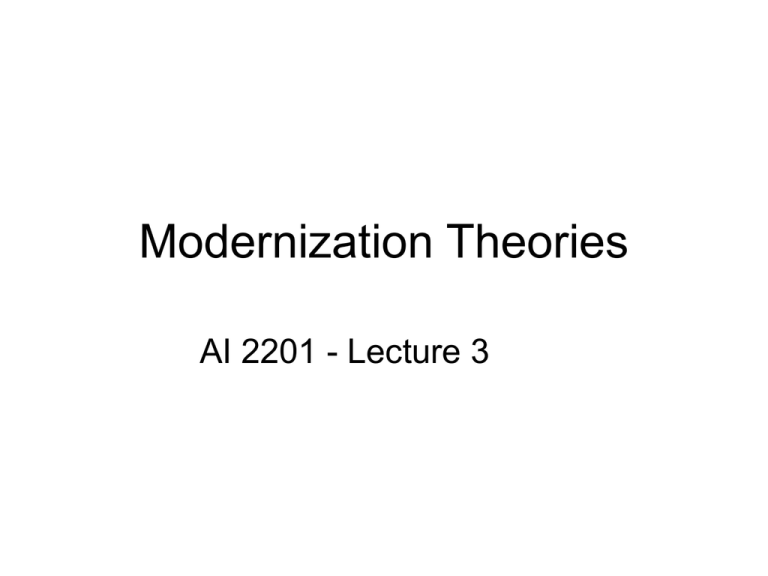
Modernization Theories AI 2201 - Lecture 3 Three themes • We can distinguish three main themes among the many multidisciplinary approaches constituting “modernization” theories. Those discussing: – 1. “Traditional” vs “modern” condition – 2. “Traditional” vs “modern” subject – 3. Stages/transition/movement 1. traditional vs modern condition • Traditional society – Non-Western societies that appear to be “underdeveloped”or “backward” (Walt Rostow) – Include (Rostow, Daniel Lerner, Guy Hunter): • • • • Slave systems of early Greece and Rome Peasants societies in early Egypt, India and China Feudal societies of medieval Europe Many people in mid XXth century Africa, Asia and LA – Features: • Relatively static as economic activity was repeated generation after generation; • Low ambition/expectation => People accustomed to a relatively stable, low output economy and believed that no more was possible; • Attempt at change was resisted by ruling elites whose power was based on religion authority and custom; • High birth and death rate; widespread illiteracy, lack of incentives for improvements 1. Cont. => attitudes to the construction of “backwardness” • Development as “hopeless” – For reason of “racial inferiority” masked in geography and climate arguments. – For cultural reason: non-Christian, non- Western people were incapable of true economic development => building on Max Weber idea of “protestant ethics” • Development as promising – Subject to the introduction of advanced technology and Western institutions – Development assistance from the West – 1960s Establishment of foreign aid programmes such as the UN development decade and the U.S. Alliance for Progress in LA 2. “Traditional” vs “modern” subject • “The essential difference between modern and traditional society . . .lies in the greater control which modern man has over his natural and social environment. This control, in turn, is based on the expansion of scientific and technological knowledge.” (Samuel Huntington 1968) • “Traditional man is passive and acquiescent; he expects continuity in nature and society and does not believe in the capacity of man to change or to control either. Modern man,in contrast, believes in both the possibility and the desirability of change, and has confidence in the ability of man to control change so as to accomplish his purpose.” (Samuel Huntington 1968) The “empirically identifiable modern man and . . .his outstanding characteristics”(Alex Inkeles 1969) • Openess to new experience • The assertion of increasing independence from authority of traditional figures like parents and a shift of allegiance to leaders of government, public affairs, trade unions, cooperatives, and the like” • Belief in the efficacy of science and medicine,and a general abandonment of passivity and fatalism in the face of life’s difficulties • Ambition for oneself and one’s children to achieve high occupational and educational goals • Are on time and show an interest and take active part in civic and community affairs and local politics • Strive energetically to keep up with the news and within this effor to prefer news of national and international import over items dealing with sports, religion, or purely local affairs Modernization as Westernization (Daniel Lerner 1958) • • • • • • Lerner sees the modern man as the “empathic” man. Here is the story: “Many generations ago, in the West, ordinary men found themselves relatively free to move” [really? Check next week on England’s “bloody legislation” following land enclosures] Physical mobility gave rise to social mobility and system of bourgeois values that take social change as normal. Mobile society => encourages rationality “for the calculus of choice shapes individual behavior and conditions its rewards. People come to see their future manipulable, rather than ordained.. .” “Whereas traditional man tended to reject innovation by saying ‘it has never been thus,’ the contemporary Westerner is more likely to ask ‘Does it work?’ and try the new way without further ado.” “The mobile person is distinguished by a high capacity for identification with new aspects of his environment [empathy]; he comes equipped with the mechanisms needed to incorporate new demands upon himself that arise outside of his habitual experience.” Modernization as Westernization (Daniel Lerner 1958): participation • • • “The high empathizer tends to become also the cash costumer, the radio listener, the voter”, I.e. the participant. “Traditional society is nonparticipant -- it deploys people by kinship into communities isolated from eachother and from a center . . .hence there is no need for a transpersonal common doctrine formulated in terms of shared secondary symbols” I.e. a “national ‘ideology’ which enables persons unknown to each other to engage in political controversy or achieve ‘consensus’” “the model of behavior developed by modern society is characterized by empathy, a high capacity for rearranging the self-system on short notice.” – isolated communities of traditional society => require highly constrictive personality – Interdependent sectors of modern society => require participation =>requires an expansive and adaptive self-system, ready to incorporate new roles and to identify personal values with public issues” (my emphasis) How would development from “traditional man” to “modern man” take place? • Through a “. . . Pervasive social transformation . . .a wholesale metamorphosis of habits, a wrenching reorientation of values . . .an unweaving and reweaving of the fabric of daily existence itself . . .[introduced and fostered by] . . .regimes audacious enough to unleash social change.” Robert Heilbroner, The Great Ascent • What does “regimes audacious enough to unleash social change” mean? Maybe ask Walt W. Rostow? 3. Stages/transition: Walt Rostow • Walt Whitman Rostow (October 7, 1916 - February 13, 2003) • An American economist and political theorist who served as Special Assistant for National Security Affairs to Lyndon Baines Johnson. • Prominent for his role in the shaping of American policy in Southeast Asia during the 1960s, he was a staunch opponent of Communism, and was noted for a belief in the efficacy of capitalism and free enterprise. • Rostow served as a major adviser on national security affairs under the John F. Kennedy and Lyndon B. Johnson administrations. • He supported American military involvement in the Vietnman War. • He wrote extensively in defense of free enterprise economics, particularly in developing nations. • Rostow was famous especially for writing a book The Stages of Economic Growth: A non-communist manifesto (1960) which became a classic text in several fields of social sciences. Stages/transition: Walt Rostow Stages/transition: Walt Rostow • I Traditional Society – Limitation on productivity; agricultural system based on hierarchical structure with narrow scope for vertical mobility; value system geared towards long-run fatalism; • II Precondition for takeoff – Science (as in late XVIIC Europe) translated into new production function in Agriculture and Industry – More general case “non endogenously but from some external intrusion by more advanced societies. These invasions . . .shocked the traditional society and begun or hastened its undoing; but they also set in motion ideas and sentiments which initiated the process by which a modern alternative to the traditional society was constructed out of the old picture” – “The idea spreads not merely that economic progress is possible, but that economic progress is a necessary condition for some other purpose, judged to be good:be it national dignity, the general welfare, or a better life for the children” Stages/transition: Walt Rostow • III Takeoff stage – “is the interval when the old blocks and resistances to steady growth are finally overcome. The forces making for economic progress, which yielded limited bursts and enclaves of modern activity, expand and come to dominate the society. Growth becomes its normal condition. Compound interest becomes built . . .into the habits and institutional structure.” (my emphasis) – New industry expands rapidly. Large profit reinvested in new industries (see I=S of Harrod Domar growth models). – Expanding requirements for factory workers and for services supporting them – Expanding urban areas. New entrepreneur class; “the economy exploits hitherto unused natural resources and methods of production” – New technology spread to agriculture, increasing productivity Stages/transition: Walt Rostow • IV Drive to maturity – “the stage in which an economy demonstrates the capacity to move beyond the original industries which powered its take-off and to absorb and to apply efficiently over a very wide range of resources. This is the stage in which an economy demonstrates that it has the technological and entrepreneurial skills to produce not everyhting, but anything that it chooses to produce.” • V High Mass Consumption – Two things happen • Real income per head reached a poitn in which large number of people command consumption far beyond food/shelter and clothing • Structure of working force changes that a) increased urban to total population and b) greater proportion of population working in offices or skilled factory jobs. Question: what does this Rostow’s representation of “stages” leave out? Question: what does this Rostow’s representation of “stages” leave out? What to make of the co-presence of “backwardness” with “modernity”? • Dualism – Dual economy. Advanced sector with capital intensive technique. Traditional sector with labour intensive technique. They are interdependent. – Marxist version: a social structure imposed by colonial power is devised to keep the two sector interdependent in this way, and using the traditional sector as a source of cheap labour. • Arthur Lewis Labour Surplus Model – Subsistence sector, agriculture. Existence of labour surplus, in the sense that overcrowded conditions. Workers tend to live in h extended families for reason of customs rather that economic advantage. Some agricultural employment is disguised employment, “workers marginal output < wages”. – Industrial or modern sector small. Wages can be kept low because jobs are easily filled by surplus labour in subsistence sector. – Development => migration from subsistence sector to modern sector. Wages are kept low initially, because new workers migrate. Profit grow relatively and absolutely. After all surplus labour is absorbed, wages start to grow and capitalists start to mechanize. – Policy implication: use migrants as cheap labour to make infrastructure for development as this will not make the country side suffer (given Lewis assumption). Nine characteristics of modernization process • • • • • • • • • (according to S. Huntington review of literature) M is a revolutionary process “comparable to the changes from prehuman to human existence and from primitive to civilized societies” M is a complex process. “It involves changes in virtually all areas of human thought and behaviour”. At minimum it includes: “industrialization, urbanization, social mobilization, differentiation, secularization, media expansion, increasing literacy and education, expansion of political participation” M is a systemic process: “changes in one factor are related to and affect changes in the other factors” M is a global process. “all societies were at one time traditional; all societies are now either modern or inn the process of becoming modern. M is a lengthy process. Hence not only revolutionary but also evolutionary. M. is a phased process. “Societies . . .can be compared and ranked in terms of the extent to which they have moved down the road from tradition to modernity.” M. is a homogenizing process. M. “produces tendencies towards convergence among societies,” which may lead “to a stage ‘at which the various societies are so homogeneous as to be capable of forming a world state.” M is a irreversible process M is a progressive process. Next week: • Through the category of “primitive accumulation” we will discuss – How the classic transition to “modernity” and the emergence of new subjectivities, is grounded on historical contingent struggles over the commons and not some sort of natural evolutionary processes through stages; – How even in the contemporary age of “globalization”, continuous “primitive accumulation” is necessary to reproduce “modern” subjectivities and allow growth and capitalist development.
